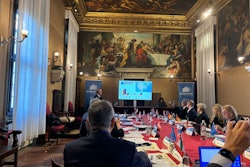A new survey of more than 100 Italian breast centers has highlighted a heavy reliance on single-use sterile items in breast biopsies, which contributes significantly to clinical waste. The findings were presented at the European Society of Breast Imaging (EUSOBI 2024) annual congress in Lisbon, Portugal.
Dr. Elisabetta Giannotti, consultant breast radiologist at the Cambridge Breast Unit, Addenbrooke's Hospital NHS Foundation Trust, U.K., and a co-author of the EUSOBI 2024 study, told AuntMinnieEurope.com on 23 October that she was not surprised to find out that most centers use sterile materials because maintaining safety is critical in clinical settings.
 Dr. Elisabetta Giannotti is co-founder and advisory member of the EUSOBI Young Club (EYC) and AuntMinnieEurope.com. All photos courtesy of Jason Kimmings and EUSOBI.
Dr. Elisabetta Giannotti is co-founder and advisory member of the EUSOBI Young Club (EYC) and AuntMinnieEurope.com. All photos courtesy of Jason Kimmings and EUSOBI.
"But the survey highlighted the extent of reliance on multiple single-use sterile items," she said. "This reaffirmed the importance of exploring and promoting sustainable practices that maintain safety while reducing waste. It showed there's a clear opportunity to support these centers in adopting more environmentally friendly approaches without compromising patient safety."
Infection rates in breast biopsies are extremely low and the use of sterile materials is not always necessary, but there is a lack of robust evidence in the literature and the authors are working to generate this evidence to support best practice, according to Giannotti.
Research methods
To find out about current practice, a panel of five radiologists led by Dr. Serena Carriero, from the Università Degli Studi Di Milano, developed a 56-item online questionnaire. The survey explored the materials used for core-needle biopsies during all procedural steps, including operator preparation, sterile fields, biopsy procedure, and sample collection. APS Senonetwork, a national organization dedicated to promoting high standards in breast cancer care, distributed the questionnaire to its extensive network of accredited breast centers from 20 February to 31 March 2024.
A total of 175 responses were received from 101 centers. Of the respondents, 77% (135/175) performed breast biopsies. Of these, 98% (129/132) performed a core-needle biopsy, 47% (62/132) fine-needle aspiration, and 73% (96/132) vacuum-assisted breast biopsy.
Among the 132 respondents performing biopsies, 58% (76/132) used sterile gloves, with 49% (37/76) using only one pair. Sterile keyboard covers are used by 16% (21/132), and 38% (48/128) used sterile probe covers. Sterile fields are used by 37% (47/128), with 31% (40/128) using one drape and 8% (10/128) using more than one.
Only 6% (8/128) used sterile gowns, with 44% of these using two gowns considering collaborators, while only 9% (12/128) used hair caps. For gauze, 77% (95/123) use one to three packs.
For anesthesia, 88% (108/123) and 85% (104/123) use respectively one syringe with one needle. During procedures, 82% (101/123) used at least one plastic cup, and 28% (35/123) used more than one.
Sterile kits were used for core-needle biopsies by 22% (27/123) of centers, and 74% (90/121) threw away all excess material, both used and new. Waste-sorting was practiced by 69% (83/121). For core-biopsy needles, 98% (116/118) used only one needle for a lesion, with 87% (103/118) using disposable needles. 74% (90/121) of respondents had never observed an infectious complication after a core-needle biopsy.
 Practice makes perfect: Hands-on training for ultrasound-guided breast biopsies proved very popular at EUSOBI 2024.
Practice makes perfect: Hands-on training for ultrasound-guided breast biopsies proved very popular at EUSOBI 2024.
In breast core-needle biopsies, there is no specific evidence for meaningful hygienic measures, and due to the very low risk of infection, only the routine use of gloves and adequate skin disinfection is recommended. "It is important to emphasize the need to minimize unnecessary use of sterile and nonsterile materials while maintaining high-quality patient care, thereby contributing to sustainable healthcare practices," the authors wrote.
What can radiologists do?
Radiologists can take practical steps to reduce waste, including single-use gloves (which do not necessarily need to be sterile), thorough skin disinfection, and covering probes, she added. "Adopting a no-touch technique -- where the needle is kept sterile by avoiding contact with non-sterile surfaces between core samples -- is essential."
As evidence grows, radiologists should stay informed and consider sustainable practices that balance safety and environmental impact, Giannotti pointed out. "In our daily practice, be mindful and think about the environment, conserve energy, reduce waste, and recycle when you can! Further advice can be found on the EUSOBI website."
Together, radiologists can drive positive changes and address unanswered questions about safe and sustainable practices, she said.
The researchers are now trying to expand their survey to a worldwide level to understand common practices across different countries. In parallel, we are conducting a prospective study to assess infection rates of breast biopsy. Additionally, EUSOBI has established a Green Sustainable Workforce, inviting anyone passionate about environmental sustainability to join.
"Promoting eco-sustainability in radiology is more relevant than ever. Our planet is facing unprecedented challenges, and there is growing global recognition of the negative impact of climate change on human health," the authors wrote.
"Major contributors to environmental pollution in healthcare include CO2 emissions from energy consumption, transportation, and waste from single-use materials. Focusing on a sustainable approach is paramount in radiology. A crucial aspect to examine is the extensive use of disposable materials in breast biopsies, which has a significant environmental impact."
You can read the full EUSOBI 2024 e-poster here. The other co-authors were Drs. Andrea Cozzi, Simone Schiaffino, Maria Adele Marino, and Massimo Calabrese. Also helping with this study were Drs. Paola Clauser, Fleur Kilburn Toppin, and Matthew Wallis.



















